I was treated to a 30-minute sneak peek of Netflix’s upcoming animated film BACK TO THE OUTBACK and subsequently, this very lively and delightful exclusive conversation with directors HARRY CRIPPS and CLARE KNIGHT talking about BACK TO THE OUTBACK.
Set in the wondrous world of the Australian Outback, BACK TO THE OUTBACK is the story of a group of Australia’s deadliest creatures who make a daring escape from the reptile house in the city zoo. Gawked at by zoo visitors, the gang is tired of children screaming and women fainting in fear at the site of their scales and fangs.
Led by Maddie, a poisonous snake with a heart of gold who was born in the Outback and brought to the zoo as a snakelet, a self-assured Thorny Devil lizard named Zoe, a lovelorn hairy spider named Frank, and a sensitive scorpion named Nigel join forces to stage a great zoo escape. They’ve never seen anything beyond the zoo and their Plexiglas containers and are spellbound by Maddie’s memories of a world where creatures are accepted for who they are. But unfortunately for our heroes, their nemesis, the cute and cuddly and beloved baby koala Pretty Boy unexpectedly becomes part of the group thanks to a slight mishap that occurs during the escape.
Starting with a swim across Sydney Harbor, hilarity ensues as our little group meets with hair-raising adventures across the continent as they are pursued by zookeeper Chaz Hunt and his mini-me son Chazzie.
Directed by Harry Cripps and Clare Knight with script by Cripps, BACK TO THE OUTBACK features the voice talents of Jacki Weaver as a croc named Jacki, Isla Fisher as Maddie, Guy Pearce as Frank, Angus Imrie as Nigel, Miranda Tapsell as Zoe, Tim Minchin as Pretty Boy, Eric Bana as Chaz, and Diesel La Torraza as Chazzie, along with Rachel House, Keith Urban, Celeste Barber, Wayne Knight, Aislinn Derbez, and Lachlan Ross Power.
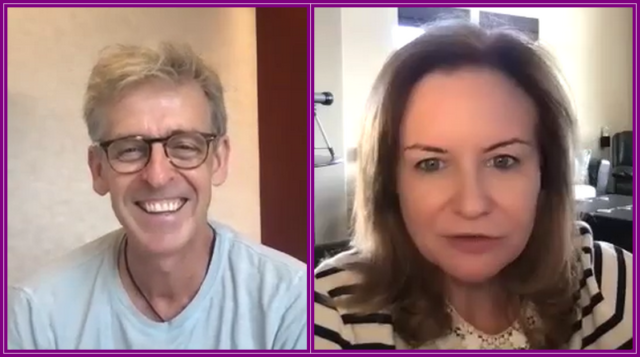
In the beginning
Within just this sneak peek, the depth of storytelling and animation is beyond evident. So quickly we not only learn about each creature, but their personalities are well defined not only with voice performances and witty dialogue but with the animation and use of color. Character designer Jesse Aclin and his team do an amazing job at bringing the characters to life, but the visualizations have to start somewhere or with someone and in this case, it’s Harry Cripps who grew up in Sydney and in the Blue Mountains, both of which are featured in the movie. As Harry relates, the Blue Mountains are “outside of Sydney and they are full of a lot of snakes and spiders and a lot of dangerous things…I always preferred them to the cute and cuddly animals.”
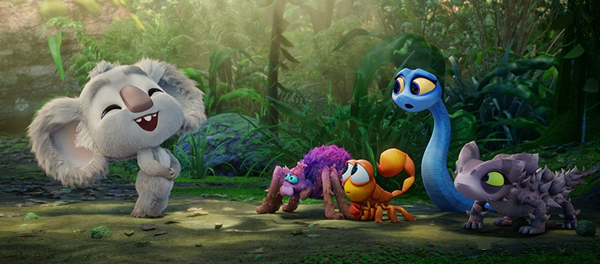
Don’t judge a book by its cover
Clare started with posting pictures of the various animals on the production office wall and found that, “So many people would focus on the animals that we really knew we needed to make them very appealing just because of the idea that people misinterpret them by how they look, which is very much a theme in the movie…so Jesse did a fantastic job of making them so appealing with his style and the stylized nature of them.
“We leaned into their natural traits as animals and that helped us use those traits to sort of push their personalities; like, spiders really do have these bizarre mating dances. So it felt natural to turn what is a bit creepy in nature into something which is really adorable, which is just a young guy who is just coming into his own body and wants to be a dancer. With Zoe the Thorny Devil Lizard, their natural body is designed to for camouflage and for escape, so we made her the super smart escape artist. We took their physical attributes and made them part of their personality personalities.
“With Maddie when her fangs come out, she is like this teenaged girl embarrassed by her braces and uses her little tail to cover her. We tried to make as many of those kinds of relatable human aspects relate to their animal aspects as well.”
Expounding on the creation of the animals, Harry and Clare are in agreement that this is “really to help the kids who have a natural interest in these kinds of creatures, these little weird creatures, but to increase that interest with a sense of relief to be able to relate to them as personalities as well.”
Going beyond the wondrous creatures I met in the sneak peek, there are so many others. Tasmanian Devils, Dung Beetles, Bush Pigs, Platypus. It begs the question of how did they distill down the number animals to include in the film or can we expect to see every animal from Australia in the film.
Laughingly, Clare quickly notes “There are some missing. We had some up on the wall like a jellyfish and a Star-Nosed Mole. There were a number of those that were in an early draft of the script but we felt we couldn’t do them all justice. So we chose the ones we could, but we certainly did have to leave out some favorites.” Piggybacking on Clare, Harry points out that are “so many animals in Australia. Bizarre-looking animals and so many bizarre, dangerous animals. It’s something Australians take great pride in, so we had to kind of pick and choose.”
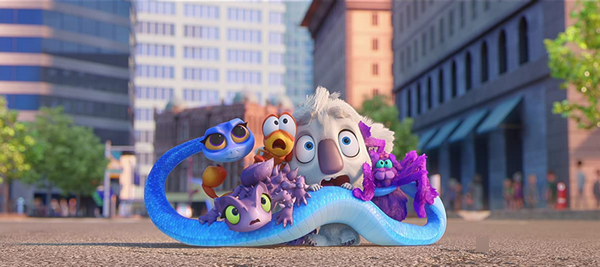
Who are we in our hearts
Already evident is their success in bringing out the emotion these creatures have in this story. There is already the theme of “who are we in our hearts” which really comes to the fore through Jacki the crocodile. Focusing on that theme through dialogue and finding the emotionality within each of the creatures while not an easy task, proved to be a joyous one.
As Harry recalls, “It was more of a joy and an exploration. We made a decision that when we first reveal the animals on screen we would see them as they are perceived. Jacki is a big crocodile, a savage crocodile. Frank’s a creepy spider coming out of a web. The moment we see them like that, we suddenly then see their personalities, we see their eyes, we see them; that these are these gentle creatures, because what we know quite what the message of our movie absolutely is – we shouldn’t judge people from the way they look on the surface. So starting out with such extraordinary-looking characters who were so obviously demonized a lot by a lot of people was a great starting point, because then we got the opportunity to sort of open up and show their heart and soul and all that sort of stuff. It was fun and beautiful and the actors are largely responsible for that. Isla Fisher just brought so much warmth to Maddie and so much humor and she added a lot of her own lines that really helped bring that character to life.” When it came to Tim Minchin and Pretty Boy, Clare loved that he had “such a great snarky way about him. He’s kind of like this intelligent, very snarky, fun character.
Amazement is something that is not lost in the crafting of these characters. For all of our escapees but for Maddie, none had seen the great outdoors or even a starry night and Harry and Clare celebrate that childlike wonder and amazement in the first-time experiences of the gang. One such scene finds Frank describing stars as “dandruff flakes”; it’s the white stuff he sees on the shoulders of people visiting at the zoo. For Harry and Clare that idea of amazement was genuinely thought out and wondering about “coming out of a cage and going ‘What the hell is that?’. How would someone who’s left in an environment in cages come out into the world and how would they interpret it.”
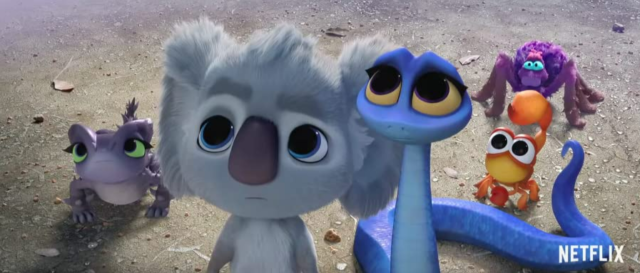
Camera Language
That idea of amazement and wonder also carries throughout into the camera perspective with aerials that zoom down to kid level, or creature level, or dutching upwards. The camera is at eye level, immersing us in the POV of the creatures so we feel as it they are talking to us. According to Clare, “It was a conscious thing with that, making a camera language. Our production designer, Mike Yamada and our head of pre-vis John Lee, both came up with these camera languages. It was like he was designing cars. We even looked at cars. When Mike Yamada was designing cars, he would say, ‘This is how a traditional car would be in animation. But this is how our cars would be looked at by our critters because they’re so small.’ There was a lot of thought in that so thank you very much for seeing that. There was a lot of thought put into that visual style and the camera language of our characters.”
Expounding on the camera language, Harry notes, “We did a lot of work in the glass, the reptile enclosure itself when the camera would actually be inside the glass container with them when we wanted to really capture their personalities see what they were feeling. Then when we pull outside and have the glass between the camera and the creature, it was more from the humans point of view of seeing them. There was a lot of thought that was put into the camera language.” And that language carries through with refraction and reflection on the water and the glass enclosures.
Color is king
Adding to the character development and visual tone of the film is color. Color is so defining, eye-popping and beautiful with our little creatures, but it also serves as a differential for “civilization” and Chaz and Chazzie. Using an entire color chart, Harry and Clare turned to Mike Yamada who “came up with the mood and the color throughout the movie; the color script we call it that you have up on the wall. It was a very conscious decision that started in Sydney where there was the blues of Sydney. The big highlight was the blues and the red of the Outback. And we were very conscious of bringing those colors as we go out into the Outback and it gets redder and redder… We said to Mike, this film follows the natural spectrum of light. We start on the cool blues of Sydney. We go to the green of the mountains. We push to the oranges, the ochers. And eventually the red of the Outback, which is when they get to the red heart of Australia. So it started with this really simple, basic natural spectrum, which was super cool. And within that Mike just really broke it down into this very extensive color script, actually building in and working with a different mood and what was happening at the time in the film. But it’s beautiful because of the colors in Australia. I know there is blue sky in California and there’s blue water and there’s desert, but the colors in Australia, and I’m not defending Australia because I’m Australian, but they do seem more vivid. The blues and the greens and the reds particularly just seem to have a more vivid hue to them.”
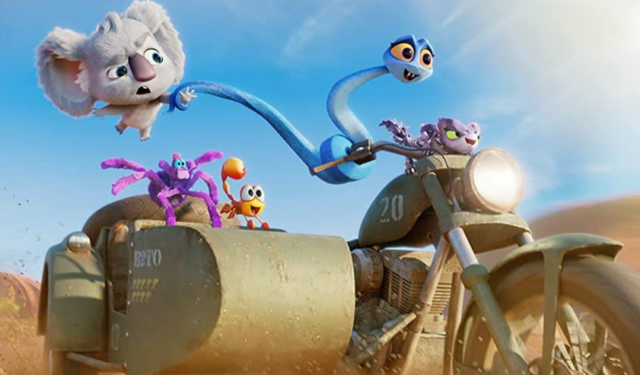
Adding Dolly
A complete surprise and total standout is a needledrop of Dolly Parton’s “9 to 5.” Laughing and thrilled at the same time, Clare gives all credit to Harry for this gem. “It was perfect. We did try a lot of songs there and Harry is the one who said it was going to work. A lot of the music is Australian artists, but this was one song that we could never top. It was so good.” Adding to the good is Rupert Gregson-Williams’ score. Known for his rich and beautiful scores, we perceive one thing but then we learn and see something different which creates a wonderful musical metaphor for what’s happening with the creatures.
Challenges & Gratification
At the end of the day after years of work on this animated film of BACK TO THE OUTBACK, one has to wonder what were the most challenging and most gratifying aspects of the process. For Harry, “Definitely the most gratifying for me was being able to sort of bring to life the little creatures that I grew up with; the snakes and the spiders and stuff that were in and out of our homes as children. It was just lovely and wonderful to be able to make them come alive and put them into a great big film.”
Leaving the most challenging aspect of the filmmaking process for Clare to comment on, it comes as no surprise that it was the pandemic lockdown. “We went into lockdown during the film. But at the same time, it turned out to be a wonderful thing. We all kind of pulled together and made this film from home. People animating around the world and we were checking in with them. So on the one hand, it was a challenge, but it was a really exciting challenge. We all feel like we’ve been together and will remember it forever.” Adding his own final thoughts on the film, Harry reflects, “We did feel a bit like the characters in our movie. We’re all in boxes, trying to break out, yearning for this beautiful place called the Outback, which is exactly the story of our creatures. And like them, the world just gets bigger and bigger once you step outside of your box or your Zoom meeting or whatever. We feel very close to this project.”
by debbie elias, exclusive interview November 2, 2021












